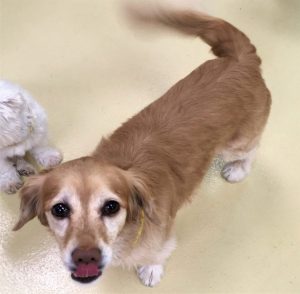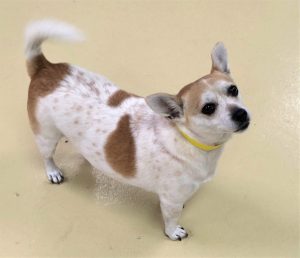Dogs have a lot to say! Understanding dog body language will help you communicate effectively with your pup.
Dogs speak mostly through body language. Learning how to speak “dog” is important because you will be able to recognize when your dog is uncomfortable, scared, or threatened. Dogs rarely bite without multiple warning signs. You will have to train your eye to see quick body movements, as they may appear for a moment and then dissolve into something else.
First, understand that most dog body language is contextual. For example, tail wagging can mean several things, from “I’m so happy to see you!” to “Please don’t come any closer!” You will need to look at the entire picture of your dog and the surrounding environment to understand.
Observe your dog at home when they are comfortable and relaxed. Pay attention to what his or her dog body language looks like in a neutral, happy state.
Happy Dogs

Happy dogs are loose and wiggly! These dogs typically have open mouths, relaxed or forward ears and relaxed or soft eyes. The base of the tail is neutral (not too low or too high) and the tail itself is most likely wagging.
These dogs probably want to interact with you or the other dogs in their environment. Pay close attention, however, because relaxed dogs can easily become uncomfortable with something or someone.
Dog body language:
- Loose and wiggly body posture
- Open mouths
- Relaxed or forward ears
- Relaxed or soft eyes
- Neutral tail base
- Play bow – front legs out, belly close to ground, rear end in the air. Means “play with me!”
- Rolling over with belly exposed
Nervous or Stressed Dogs
Nervous dogs have tense overall body posture. Their mouths will be closed, their ears will be pinned back, and they will have wrinkles around their eyes. They may also exhibit a “whale eye,” where you can see the whites of their eyes. The base of the tail is low, and the tail is tucked between their legs.
Nervous dogs will use calming signals and exhibit displacement behavior. Displacement behaviors and calming signals may be used to calm themselves down, show non-aggressive intent, or diffuse situations.
Calming signals are used to signal to other dogs that they mean no harm. Looking away, raising his or her paw, sniffing, sneezing, scratching, blinking, yawning, and lip licking are all examples of calming signals. The dog may also shake themselves off, sit, or lie down. These signals mean “I’m uncomfortable or scared and I mean you no harm. Please leave me alone.”
Displacement behaviors are displayed when a dog wants to do two different conflicting things at once. For example, a dog may want to approach something, but may also be scared. Instead of approaching the thing, they might stretch, yawn, shake themselves off, sniff, or look away. This is equivalent to a person scratching his or her head when they are confused about something.
Dog body language:
- Closed mouths
- Pinned back ears
- Wrinkles around eyes
- Whale eye
- Low tail base, tail tucked between legs
Signs of stress:
- Looking away
- Yawning
- Sneezing
- Lip licking
- Shaking off
- Sniffing
- Stretching
- Raising his or her paw
Alert Dogs
Alert dogs have tense or forward overall body posture. They will typically have closed, tense mouths, forward ears, and wide eyes. The base of the tail will be high and the tail may wag. These dogs are interested in something and are undecided how to react. This body posture usually only lasts briefly before the dog decides to react in playfulness, fear, or aggression.
Dog body language:
- Forward or heightened body posture
- Closed, tense mouths
- Forward, “up” ears
- Wide eyes
- Hard stare
- Raised tail
- Tail may be wagging or still
Aggressive Dogs 
Dogs exhibiting aggressive body language will be very tense and stiff, possibly frozen. The muscles around their mouths and eyes will be tense. In addition, these dogs will probably be baring their teeth and their hackles will be raised. Their ears and tails may be raised or lowered, depending on whether the dog is acting offensively or defensively.
The dog in the first picture to the right is displaying defensive aggression. The dog in the second picture is exhibiting offensive aggression. Both of these dogs are clearly saying “Back away from me!” and may attack at any time.
If you ever encounter a dog and he or she starts to exhibit aggressive body language, stop your approach, move slowly, and appear non-threatening. In addition, avoid eye contact, look away, and remain calm and confident. NEVER run away!
Dog body language:
- Tense, stiff, or frozen body posture
- Tense muscles around eyes and mouth
- Curled lip with teeth baring
- Raised hackles on shoulders/neck
- Ears may be forward (offensive) or back (defensive)
- Tail may be raised (offensive) or lowered (defensive)
Still need help understanding dog body language?
Take one of our group obedience or zen dog classes! Feel free to contact us with any additional questions.

My dog sits swaying back and forth looking over her shoulder, and sometimes she walks like her back legs don’t work
No hay nada más frustrante y peligroso que un perro que no obedezca. Te planteo una situación: miras el reloj y te das cuentas de que llevas de paseo una hora. Tu cachorro ha corrido muchísimo detrás de su pelota, ha jugado con otros amigos peludos y está, en estos momentos, echado en el suelo con la lengua fuera. Piensas que ha llegado el momento de volver a casa, lo llamas, pero no se mueve.
It was interesting to me when you mentioned that nervous dogs will display calming signals. I would imagine that some dogs will bark and whine as well when they are super nervous. It could be a good idea to consult with an expert if you are worried about the messages your dog is trying to convey.